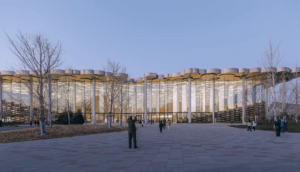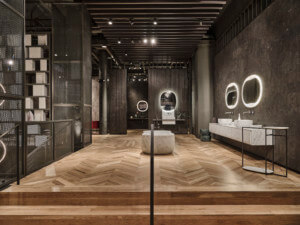Bronze facade is inspired by Chinese historic architecture.
In designing the facade of the new Waldorf Astoria Beijing, Chicago-based Adrian Smith + Gordon Gill Architecture (AS+GG) set out to create a contemporary expression that maintained a relationship to the city’s historic context. The project, after all, is within walking distance of the Forbidden City and many of the Chinese capitol’s famous Hutongs. “How do we make the experience of going to a hotel special and what about it would be Chinese?” enquired founding partner Gordon Gill. “From an experience standpoint, what about the wall could change your experience in your room?” The answer was a bronze facade with a bay window system that protrudes out from the face of the building.
- Facade Manufacturer
Yuanda Exterior Wall Manufacturer - Architects
Adrian Smith + Gordon Gill Architecture - Facade Installer
Yuanda Exterior Wall Manufacturer - Facade Consultant
Lerch Bates - Location
Beijing, China - Date of Completion
2014 - System
bronze panels with modular bay windows and solar shading - Products
bronze, low-iron glass
The bay windows are not uniform, however, but tuned to differing angles and orientations to frame particular views. This makes the whole building “like a compound eye,” according to Gill. Working in co-ordination with Toronto-based Yabu Pushelberg, the interior architects, the team developed a modular system based on the size of the rooms and the dimensions of the structural bays. It led to a cleaner design that was easier to construct.
While the texture created by the bay window system is ornamental and connected to the context, it also provides solar shading. Shade provided by horizontal glass fins above the recessed vertical windows allowed the architects to use very clear low-iron glass to give the best views possible. “It is not tainted by a tint or a color in any way. There is a low-e coating on the glass, but it’s a low-level so it’s not reflective on the inside,” said Gill.
The architects developed the bronze details, and the client initially liked it. The designers were excited, but nervous about it actually happening. Gill explained, “We went back to the chairman a few weeks later for the presentation, and he came back and said ‘Well I want you to know that I had lunch with the mayor and I told him that this building was going to be bronze, and he loved it, so now we have to do it.’ So it was just a matter of detailing out.”
Metal panels can present technical challenges, especially catalytic failure between the z-clips and the metal panels, including rusting, corrosion, or telegraphing through the panel. The design team mitigated these problems, so the main challenge was to get the color right. Bronze is not a typical material, so they had to rely on their own blend of copper, nickel, and brass to achieve a warm, golden color that was not too yellow, red, or brown, but somewhere in between. There is variation from panel to panel—an unpredictability that adds to the texture and richness of the facade.
The unusual material was inspired by two large bronze pots at a nearby historic hospital building, which the client had referenced. This decision exemplifies the ethos of the building, which was to capture the elegance and quality of Waldorf Astoria’s brand in contemporary yet contextually sensitive building. It has come to serve as an example to luxury hoteliers around the world.









